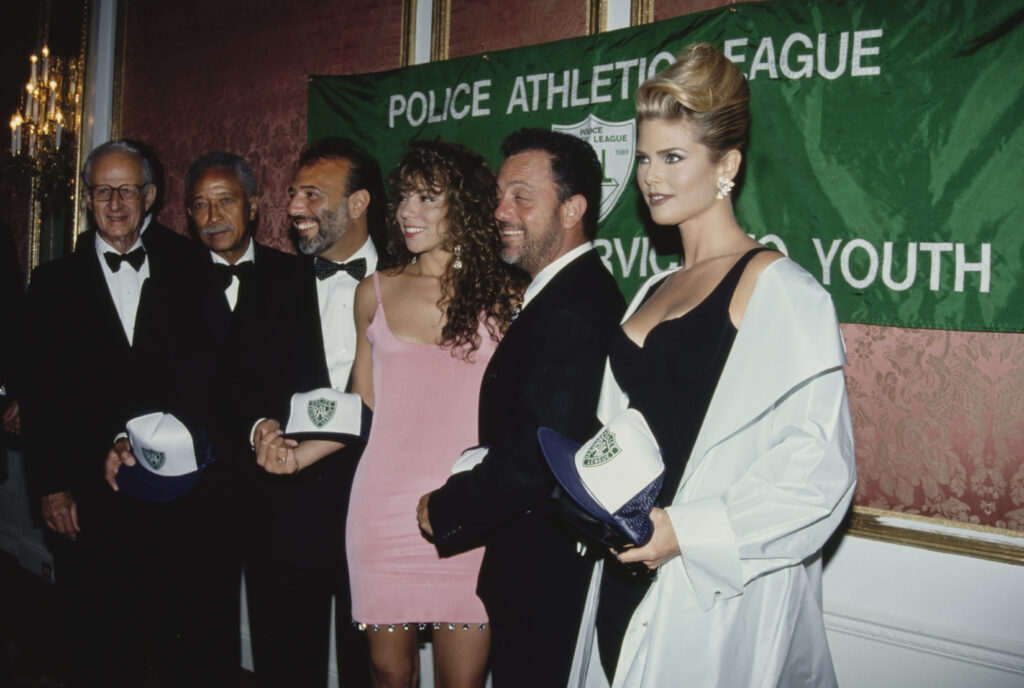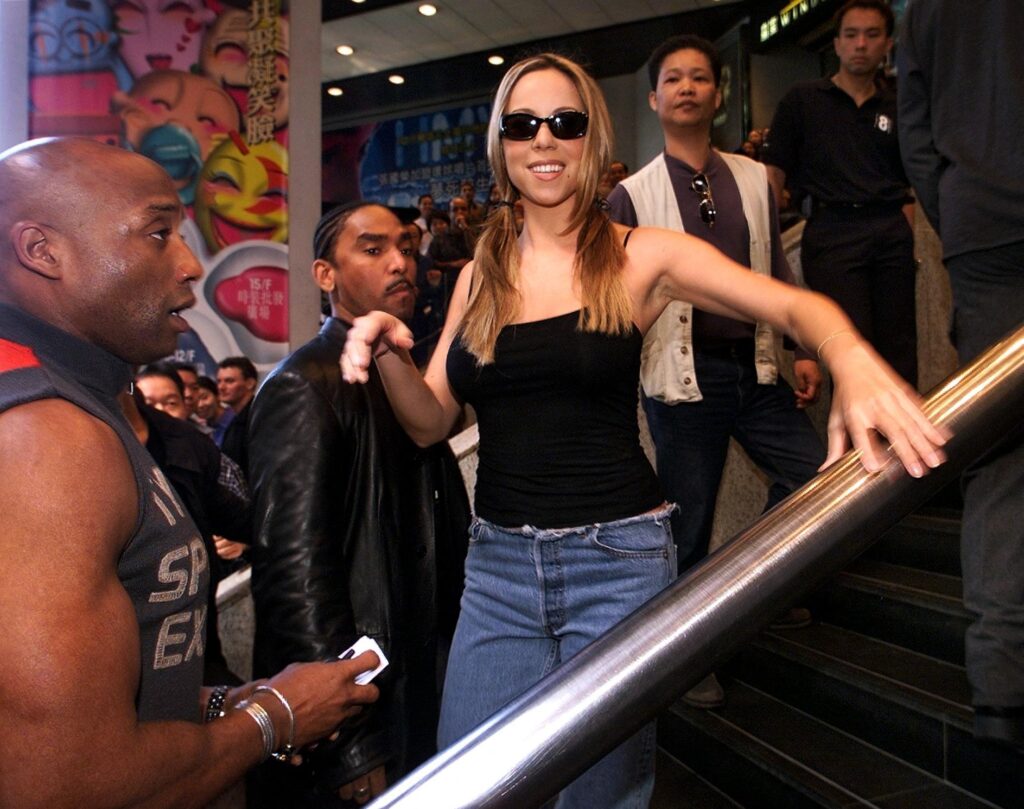Even if you’ve never done a deep dive into Mariah Carey’s decades-spanning discography, it’s impossible to deny her impact on the culture. As a young, mixed race woman stepping into spotlight as the 90s began, the New York-born talent played a crucial role not only in addressing awkward racial tensions of the time. “[Mariah] became something of an avatar for biracial identity, a validating presence for some and a source of both curiosity and discomfort for others,” Brittany Luse wrote for Vulture.
Racial identity aside, Carey’s distinct, genre-bending voice paved the way for virtually every female R&B singer to come after her, from Leona Lewis to Beyoncé. She’s always had a bold style to match her singing chops, and is even credited with helping to popularize low-rise jeans throughout the 2000s thanks to her 1999 “Heartbreaker” music video with Jay-Z. Through all of her ups and downs, Carey has remained confident in herself, though she’s quietly been coping with bipolar disorder for her entire career, making her consistency even more impressive. Keep scrolling to reflect on the six-time Grammy Award winner’s most monumental moments from her early career.
1990
Just one week before her self-titled debut album arrived, Carey had the opportunity to sing “America the Beautiful” at the 1990 NBA Finals. She caught the world’s attention with her one-of-a-kind vocal range, and only continued to grow her fanbase thanks to singles like “I Don’t Wanna Cry,” “Someday,” “Love Takes Time,” and “Vision of Love.” The latter title, in particular, sent shockwaves through the music video as all of the mother of two’s contemporaries attempted to emulate her skills.
“‘Vision of Love’ [set] the bar insanely high for notes stretched louder, longer and knottier than most pop fans had ever heard,” David Browne wrote in the New York Times. “A subsequent generation of singers, including [Christina] Aguilera, Jennifer Hudson, and Beyoncé built their careers around melisma. Men like Brian McKnight and Tyrese also indulged in it, but women tended to dominate the form.”
Columbia Records spent over $1M promoting the “Obsessed” hitmaker’s Mariah Carey LP, and their efforts paid off as it eventually landed atop the Billboard 200 for a consecutive 11 weeks. The rising star won Grammy Awards for Best New Artist and Best Female Pop Vocal Performance, proving to her competition that she wasn’t coming to play. Besides her astounding voice, Carey’s uber-feminine, over-the-top style helped to set her apart from edgier artists of the era.
1991

Her debut got off to a slow start, but in 1991, Mariah Carey was the best-selling LP in the country, boasting worldwide sales of 15M. The New York native didn’t let success make her cocky, and she continued to pour her soul out in the studio while working on her Emotions project, which landed on September 17th. Critics blasted the 10-song effort for lacking originality, though they did observe it was a step up in maturity from her debut. It amassed eight million in global sales, falling short of MC, and Carey’s decision not to tour at the time raised eyebrows in the media.
While the Guinness World Record holder attributed it to stage fright and the vocally challenging nature of her work, those playing Devil’s Advocate suggested that she’s a “studio worm,” unable to replicate her perfect pitch in front of a live audience. Besides those comments, the 54-year-old additionally found herself feuding with Ben Margulies over royalties after they worked together writing songs for MC.
1992
With one of the most prominent labels in the industry backing her, it’s not surprising that Mariah Carey and her crew quickly crafted the perfect comeback to haters debating whether she could perform live or not. Her 1992 MTV Unplugged episode remains a favorite to this day – particularly her cover of the Jackson 5’s “I’ll Be There,” which eventually became her sixth No. 1 single on the Billboard Hot 100 chart.
1993

1993 was a big year for Carey for several reasons. She was just 23 years old when she and Tommy Mottola exchanged vows, and him being 20 years her senior caused some discomfort among the public. They wed in a half-million dollar ceremony at Saint Thomas Church before moving into a 51-acre estate in New York, where the R&B icon now admits to feeling imprisoned.
At the end of that August, her adult contemporary/pop album, Music Box made a splash thanks to singles like “Dreamlover” and “Hero.” The latter of the two is widely recognized as an LGBTQ+ anthem, and the whole LP is one of the world’s highest-selling projects of all time, moving upwards of 28 million copies. To accompany that, Carey finally felt confident enough to conquer the stage, touring in six different cities much to the delight of her supporters.
1994
It’s hard to imagine a time when Carey wasn’t recognized globally as the Queen of Christmas, but it wasn’t until 1994 that her first holiday album changed the world forever. “All I Want for Christmas Is You” remains the best-selling holiday song by a female artist, and since 2019, its popularity has only further risen. That year it peaked on the Hot 100 for the first time – a tradition that’s only continued into the present day.
The mid-90s were also a great time of philanthropy for the Songbird Supreme, who began working with the Fresh Air Fund regularly. Elsewhere, she opened Camp Mariah (still running today) in Fishkill, New York, for inner-city youth to have a place where they could embrace their artistic talents and learn about opportunities for careers in those fields.
1995
Those who read the record-breaking lyricist’s 2020 memoir, The Meaning of Mariah Carey will already know that she lived something of a double life in 1995. When not in the booth crafting her Daydream LP for its September debut, the mother of two was crafting alternative rock hits for a band called Chick, whom she aided with writing, production, vocals, and art direction. “I was playing with the style of the breezy-grunge, punk-light white female singers who were popular at the time,” Carey wrote. “I totally looked forward to doing my alter-ego band sessions after Daydream each night.”
Unfortunately, complications with Columbia arose, as they refused to release Chick’s Someone’s Ugly Daughter project with their star’s vocals. Instead, Carey’s friend Clarissa Dane replaced her as the group’s face, though the multi-talent still lent her skills to direct their “Malibu” music video. In her own music, the blonde beauty notably shifted from pop to R&B and hip-hop sounds, causing Daydream to become one of Carey’s best-received works to date.
“Fantasy” was the lead single from her 1995 album, and its relevance remains high today as it was sampled by Atlanta-based femcee Latto just a few years ago on “Big Energy.” The song marks the first time Carey was responsible for directing her own visual, as she wasn’t impressed with how past projects turned out. “One Sweet Day” featuring Boyz II Men is another standout from the tracklist, spending 16 consecutive weeks atop the Hot 100, and “Always Be My Baby” gave the East Coaster her eleventh chart-topper. This put her among the ranks of Madonna and Whitney Houston, only further cementing superstar status for the “Touch My Body” artist.
1996

In 1996, Carey took full advantage of her consistently growing fanbase overseas on the Daydream World Tour. She performed three shows in Japan and four throughout Europe while promoting her genre-bending LP. With an incredible discography already taking shape, Forbes gave the former American Idol judge her financial flowers too, naming Carey the year’s top-earning female musician, reporting that she generated an estimated $32 million thanks to her various creative endeavors.
1997
On May 30th, Carey confirmed her separation from the “incredibly controlling” Mottola after just four years of marriage. Afterward her image and music became noticeably more urband and sexy, particularly in the visual for her Butterfly LP’s lead single, “Honey.” Over a decade down the road, the Queen of Christmas declared the 1997 release as her “magnum opus, a turning point in both her life and career,” though it failed to reach the numerical heights of past albums like Music Box and Daydream. What really stands out about Butterfly is the creative’s distinctly breathier vocals. Some saw this as a sign of maturity, but as always, skeptics put in their two cents about the possibility of Carey’s voice being on its way out.
With a self-proclaimed “new lease on life” carrying her forward, Carey felt ready to take on the world more vibrantly than ever before. She began a short-lived relationship with MLB icon Derek Jeter, and was among a star-studded list of performers who contributed to the Men in Black soundtrack. For that, she joined forced with Trey Lorenz on “Make You Happy.”
1998

Things might not have worked out with her first husband or her athlete beau, that doesn’t mean Carey was ready to give up on love. In 1998 she and fellow vocalist Luis Miguel began heating up the tabloids, and he’s rumored to have inspired songs of hers such as “The Roof (Back in Time)” with Mobb Deep and “My All.” They ultimately went their separate ways in 2001, but fans still wonder what could’ve happened longterm between the entertainers.
Carey spent the winter of ’98 on her Butterfly World Tour, and in April, she joined Aretha Franklin, Celine Dion, Shania Twain, and other renowned voices to perform at the VH1 Divas benefit concert. Though it didn’t arrive until 2001, it was actually in the late 90s when the Precious actress began work on her Glitter movie and album. When development on that became a headache, the songbird returned to work on the #1’s LP Sony execs were requesting. Carey shined on her cover of Brenda K. Starr’s “I Still Believe,” and connected with Whitney Houston for another inspiring anthem, “When You Believe.” The latter appeared in The Prince of Egypt‘s soundtrack, marking yet another film credit for Monroe and Morroccan’s mom.
1999
Much to the delight of music lovers, Carey finished the decade as consistently as it began. Her Rainbow album brought some much-needed color into our lives on November 2nd, marking the end of her contract with Sony. For obvious reasons, the fashionista was eager to separate herself from her ex-husband’s label so she worked quickly to complete the project in just a few months. She connected with new songwriters like David Foster and Diane Warren, generating No. 1 hits like “Heartbreaker” featuring Jay-Z and “Thank God I Found You” together. The visual for the former remains one of the most expensive ever made, reminding us once again of Carey’s lavish taste.
For all that achieved throughout her career so far, the starlet was given a Congressional Award for “contributing to expanding opportunities for all Americans through their own personal contributions, and [setting] exceptional examples for young people through their own successes in life.” In addition to that, Billboard declared Mariah Carey the most successful artist of the decade at the end of the 90s, and she had her debut movie role in ’99s The Bachelor.
